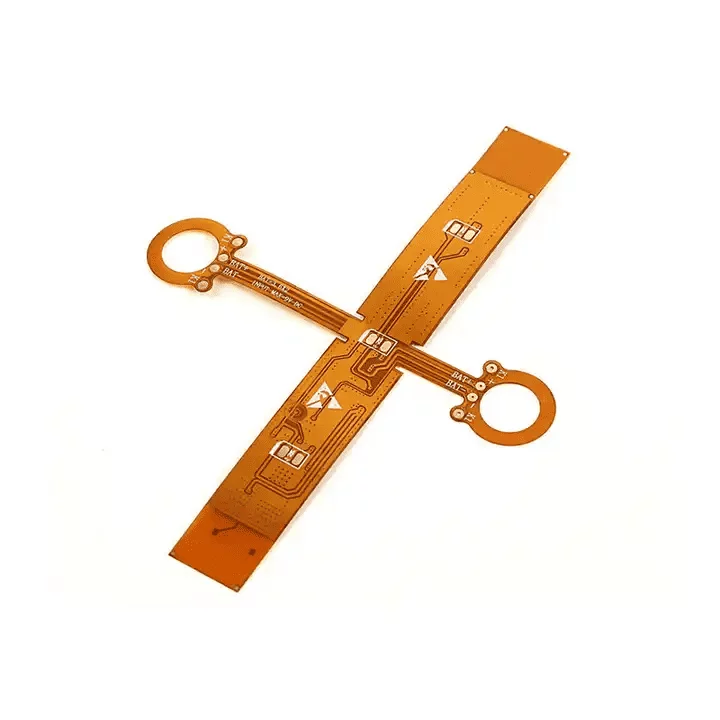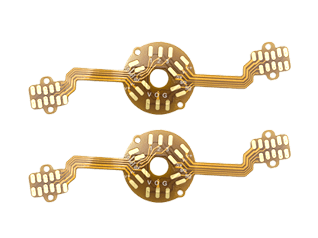Flexiable PCB Quick Quote

Understanding Flexible PCBs
Flexible printed circuit boards (PCBs), which can also be called flex circuits, represent electronic connections made with flexible plastic substrates, a key innovation in PCB design.
This PCBs can bend fully around a circle and withstand 500 million flex cycles which makes them perfect for use in moving environments. Since their introduction in the 1950s, flexible PCBs have become essential for modern electronic products, paving the way for innovations in rigid-flex PCB technology and the suppliers of flexible materials.
Single-sided flexible PCBs, which represent the simplest form, consist of four main components including a substrate, a conductive copper layer, an overlay material, and a silkscreen layer, all of which can be made from flexible polyimide. Their affordability and versatility has made these products popular across various applications, especially in the realm of electronic devices.


Flexible PCB Structure and Material Composition
The base material of flexible PCBs is usually polyimide, which combines with an adhesive layer, a conductive copper layer, and a protective coverlay, making it a preferred material used in flexible circuit manufacturing.
Additional support can be provided by adding stiffeners made from polyimide or metal materials. Anti-tarnish coatings and ENIG surface finishes increase conductivity and protect against oxidation, enhancing the overall performance of the circuit board materials. The design specifications incorporate controlled impedance together with heavy copper layouts to manage increased electrical currents used in flexible PCBs.
Types of Flexible Circuits
Flexible circuits deliver both substantial space savings and enhanced reliability compared to conventional rigid circuits, making them a preferred choice in modern electronic devices. Flexible circuits replace bulky wire harnesses and offer weight reduction along with better heat management for automotive and aerospace applications.
Flexible circuits streamline assembly operations by removing the necessity for multiple rigid boards and connectors, which leads to faster production times and more dependable results in flexible circuit manufacturing.
Single-Sided Flexible Circuits
Single-sided flexible circuits represent the simplest form which contains one conductive layer positioned on a flexible dielectric film.
Protective coatings enhance durability when components are soldered to one side of the flexible printed circuit board material, particularly under high temperatures. Their low cost combined with functional versatility makes them popular among various types of PCB applications.
Double-Sided Flexible Circuits
Flexible circuits with two conductive layers include plated through holes that enable connections on both sides. Protective cover layers enhance durability. These circuits find widespread application in sophisticated products such as dashboard components and lighting systems.
Multi-Layered Flexible Circuits
Multi-layer flexible PCBs combine multiple copper layers together with plated through holes and dielectric layers to achieve better functionality, especially when using advanced flex material. Complex products including mobile phones and satellites benefit from the use of flexible circuits, which are critical in high temperatures.
The use of discontinuous lamination achieves maximum flexibility while different via types solve design challenges in the context of flex PCB technology.
Rigid-Flex Circuit Options
Rigid-flex circuits create a unified structure by integrating rigid and flexible substrates through plated through holes, making them an essential component in flexible and rigid-flex applications.
These features make them highly dependable while maintaining compactness for both military and commercial purposes, particularly in the context of size and weight. By mounting components on both sides, the structure of flexible PCB improves space efficiency.
Advantages of Flexible PCBs
Flexible PCBs deliver both improved functionality and financial benefits, particularly by reducing assembly costs while considering the size and weight. Flexible PCBs demonstrate strong performance under extreme temperatures and maintain resistance to both radiation and chemicals while enabling easier integration of components in various electronic devices. Flexible PCBs offer ideal solutions for military, automotive, and consumer electronics due to their compatibility with numerous connectors and components, showcasing their versatility in PCB design.
Alternative bonding techniques combined with adhesive-less laminates lead to better performance and improved thermal management in flexible printed circuit board material.
Key Design Considerations
Flexible PCBs gain popularity due to their thin streamlined design which supports effective heat dissipation along with improved airflow. Their resistance to extreme heat and chemicals enables them to function properly in harsh environments.
System reliability improves when interconnection points are minimized, and the use of controlled impedance and differential copper structures allows for broader application possibilities in flexible PCB fabrication.
Manufacturing Processes
Manufacturers produce flexible circuit boards through both subtractive and additive methods. Subtractive manufacturing methods begin with a complete metal surface and carve out necessary sections while additive manufacturing builds precise metallic paths, which are essential in flexible PCB fabrication.
Subtractive processes provide extensive configurability while additive processes allow precise control of material deposition in flexible circuit manufacturing, particularly for flex PCB applications.
Cost and Turn-Time Factors
Material selection significantly impacts PCB cost, especially when considering the use of flexible materials. Polyimide flexible PCB materials cost more than traditional PCB materials, but their durability makes them ideal for many applications.
Production turn-times extend when manufacturers use complex design and fabrication processes, particularly in rigid PCBs and the immersion techniques involved. Photo and laser imaging techniques represent advanced methods that improve cost efficiencies. Meeting IPC standards is required for production and affects production schedule durations, especially in the context of flex PCB manufacturing.
Selecting a Competent Manufacturer
It’s essential to verify that your PCB manufacturer has the required certifications and registrations before making a selection.
Choose Well Circuits Co.,LTD who offer complete turnkey solutions to prevent communication issues. Advanced assembly equipment and high-quality-to-cost ratios play critical roles.
Industry Standards Overview
Flexible PCBs require consistent quality and reliability which industry standards IPC-2223 and IPC-6013 support. IPC-2223 sets design standards for flex and rigid-flex PCBs. While IPC-6013 specifies performance qualifications and testing requirements together with quality assurance measures for flexible PCB fabrication, it also addresses the unique challenges of different types of PCBs.
Practical Designing Tips
Designers need to know the necessary flexing range to ensure durable flex PCBs, which are essential in the use of flexible circuit manufacturing.
System reliability increases through flex circuits which minimize interconnections and possible failure areas. These boards provide substantial space and weight benefits over traditional ones while removing wiring mistakes, making them ideal for flexible and rigid-flex designs.
Common Applications of Flexible PCBs
High-density interconnects (HDIs) use flexible PCBs extensively to achieve compact circuit designs. Consumer electronics and automotive manufacturing alongside medical devices and aerospace applications rely on flexible PCBs as essential components, demonstrating their versatility across many applications.
Flexible PCBs Flexible PCBs improve reliability while decreasing assembly time and expenses, enabling compact product designs, which is a significant advantage in the realm of flexible circuit manufacturing, particularly for rigid flex applications.
Potential Disadvantages and Challenges
The specialized production processes associated with flexible PCBs result in elevated initial costs due to advanced fabrication techniques and the specific board materials used, such as FR4 and flexible polyimide. Skilled workers using precise methods are necessary for assembly to prevent damage. Modifying or repairing flexible PCBs demands complex procedures and extensive time commitments, particularly in the context of the disadvantages of flexible PCB design. The production of flexible PCBs requires specialized equipment which many manufacturers do not possess because this technology remains relatively new. Flexible PCBs deliver important advantages, yet they need thorough evaluation concerning their assembly and upkeep difficulties in the context of flexible circuit manufacturing.
WellCircuits supports 1-32 Layers flexible PCB, RF PCB manufacturing. if you have any RFQ, please feel free to contact me.

